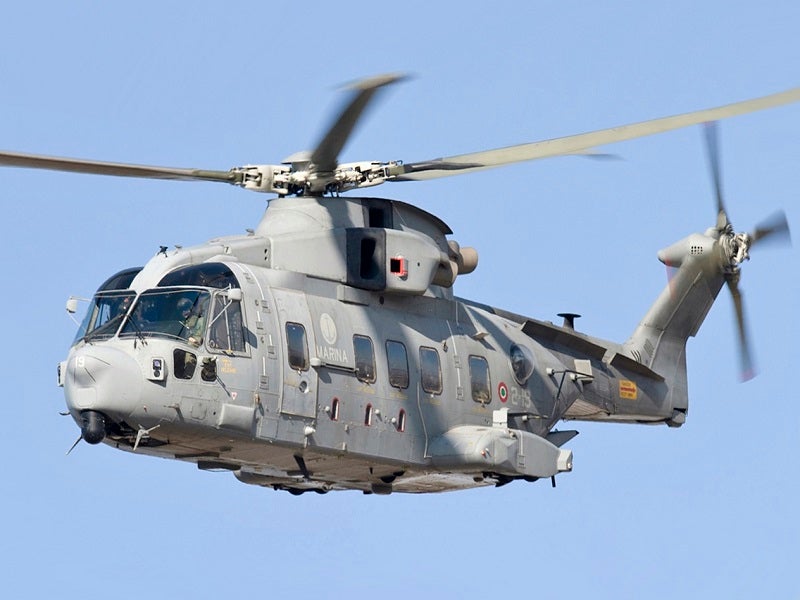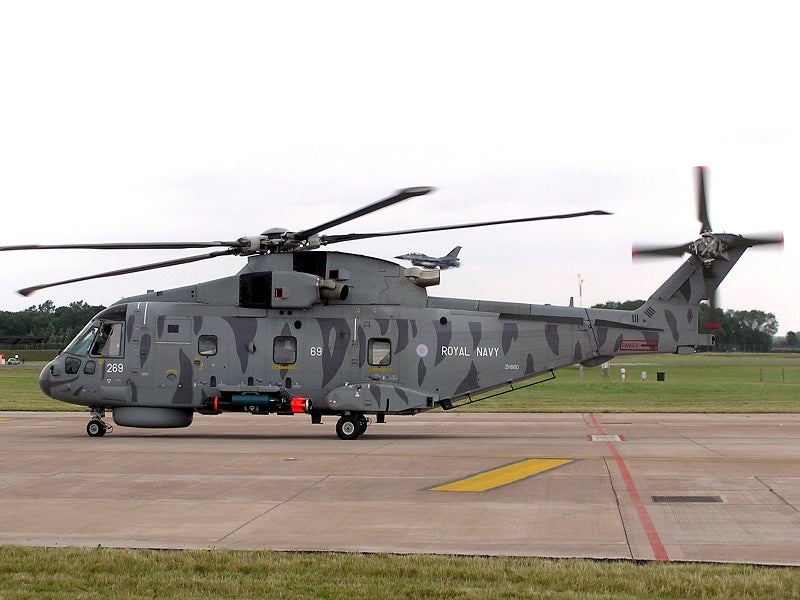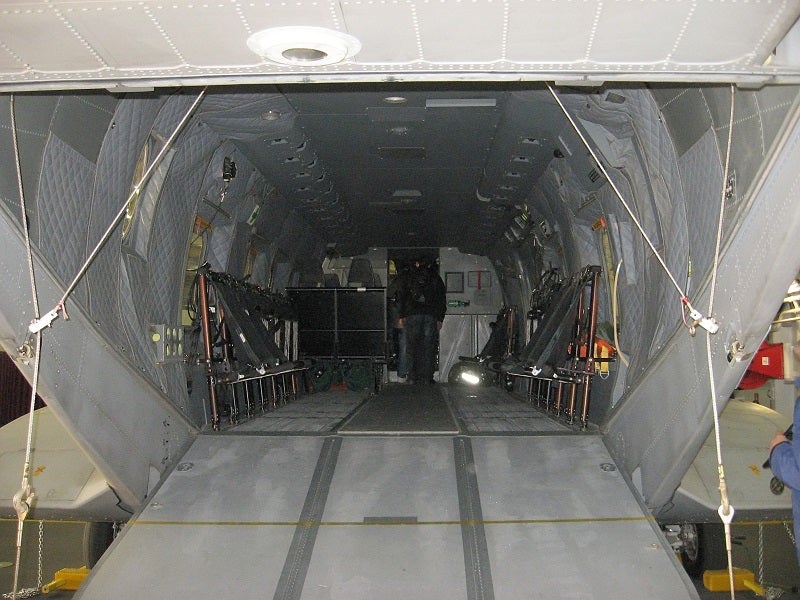The AW101 (EH101) military utility medium lift helicopter is manufactured by global aerospace and defence company Leonardo Company. It was previously manufactured by AgustaWestland (formerly EH Industries), a joint venture company formed by Italy’s Agusta and British company GKN. AgustaWestland merged into Leonardo, which was previously known as Finmeccanica, in 2016. The multi-role helicopter can be flexibly deployed on missions such as tactical troop transport, utility support, maritime interdiction operations, reconnaissance, anti-surface warfare, and search and rescue (SAR) operations.
The EH101 helicopter was renamed the AW101. It is also produced in naval and civil versions.
AW101 design
The most important aspect of the helicopter’s design is the common platform that can be configured into multiple roles.
The rugged modular structure incorporates crashworthy and damage-tolerant features, including a five-blade main rotor, four-blade teetering rotor and main lift frame, which includes multiple primary and secondary load paths.
The fuselage is mainly of aluminium-lithium construction. The aerodynamic rotor blades are constructed from carbon / glass with nomex honeycomb and rohacell foam. Active vibration control of the structural response (ACSR) uses a vibration-cancelling technique.
The helicopter’s composite rotor hub has low hinge offset, while the rear ramp for entry and exit is hydraulically actuated. The undercarriage has twin wheels for better balance. The exit routes and windows are considerably larger in size to accommodate more personnel. The large sliding cargo door, which is about 1.8m-wide, and rear ramp help for quicker movement of the personnel and equipment in and outside the aircraft.
The helicopter operates in temperatures ranging from -40°C to 50°C. The fatigue life of the helicopter’s airframe is approximately 10,000 hours.
An ice protection system allows operation in known icing conditions. An engine inlet particle separator system provides protection in sandy environments. High flotation tyres and efficient landing gear permit take-off from soft or rough terrain.
AW101 cockpit
The cockpit is equipped with armoured crew seats able to withstand an impact velocity of 35ft/s. Dual flight controls are provided for the pilot and co-pilot, but the helicopter is capable of being flown by a single pilot.
The pilot’s mission display unit is supplied by Northrop Grumman (formerly Litton). The electronic instrument system includes six high-definition, full-colour displays, together with an optional mission display.
A forward-looking infrared (FLIR) system display and digital map can be installed. Portuguese and Danish Air Force helicopters have FLIR Systems Star SAFIRE thermal imagers. DRS Technologies of the USA supplies the flight control computers.
EH101s for Denmark and Italy are fitted with Selex Communications LOAM laser obstacle avoidance and monitoring system. In the Norwegian AW101 SAR Queen configuration, the cockpit is equipped with five large display screens for the pilots to view 3D images obtained from pre-loaded maps on the onboard computer.
Military utility and naval weapons
Naval versions of the AW101 can be armed with two anti-ship missiles, or up to four torpedoes and depth charges.
Armament options for military utility variants include a chin turret for a 12.7mm machine gun or pintle-mounted machine gun. The stub wings provide the hard points for mounting of rocket pods.
Countermeasures of AW101
The AW101 is equipped with infrared jammers, such as the Northrop Grumman Nemesis, directed infrared countermeasures, missile approach warners, chaff and flare dispensers, and a laser detection and warning system.
Cargo systems
The military version AW101 has accommodation for 30 seated or 45 standing fully equipped combat troops. The cabin has room for a medical team and 16 stretchers or for palleted internal loads. The maximum ramp load is 3,050kg for vehicles such as Land Rovers.
The heavy-duty cabin floor and ramp are equipped with flush tie-down points, a roller conveyer for palleted freight and a cargo winch for non-self-loading freight.
An underslung load hook can carry external loads up to 12,000lb, and the load measurement is displayed in the cockpit. A rescue hoist and a hover trim controller are fitted at the cargo door.
Avionics and mission systems
The AW101 is equipped with two military standard 1553B multiplex databuses, which link the helicopter management, avionics and mission systems. The Smiths Industries OMI SEP 20 automatic flight control system is a dual redundant digital system, which provides auto-stabilisation and four-axis auto-pilot operation.
The navigation system includes a global positioning / inertial navigation system, instrument landing system (ILS), VHF omnidirectional radio range (VOR), tactical air navigation (TACAN), and automatic direction finding. The avionics suite also includes a health and usage monitoring system (HUMS). 2
Armament
The AW101 transport helicopter is armed with five general-purpose machine guns, two 960kg (2,116lb) anti-ship missiles, four homing torpedoes, depth charges, and rockets.
AW101 engine
The military version of the AW101 is powered by either three General Electric CT7-6 turboshaft engines, rated at 1,491kW, or three Rolls-Royce Turbomeca RTM322 turboshaft engines, rated at 1,567kW.
Each engine is fed from a dedicated self-sealing fuel tank using dual booster pumps and a cross-feed system. The Rolls-Royce engine has been chosen by UK, Canada, Japan, Denmark and Portugal. The GE engine was selected by Italy.
The three tanks hold 3,222l of fuel. The fourth tank acts as a reservoir supply to top up the main tanks during flight. There is capacity for an additional transfer tank to increase the helicopter’s range.
The range can be extended by the hover in-flight refuelling (HIFR) capability. The crew can select pressure for refuel, defuel, jettison and buddy-to-buddy refuelling.
Performance
The AW101 transport helicopter can fly at the rate of 10.2m/s. The maximum and cruise speed of the helicopter are 309km/h and 278km/h respectively.
The maximum range and service ceiling are 927km and 4,575m, and the maximum endurance is four hours 50 minutes. The helicopter weighs around 10,500kg and the maximum take-off weight is 15,600kg.
AW101 Merlin and Cormorant helicopter orders
The UK Royal Air Force received 22 AW101 Merlin HC3 medium support helicopters, with the first entering service in January 2001. A total of 44 were delivered to the UK Royal Navy.
Italy ordered 20 AW101s with options for a further four. Nine ASW (anti-surface and anti-submarine) plus one optional with L-3 Communications HELRAS active dipping sonar
(deliveries complete), four plus two optional AEW (airborne early warning), four utility and four amphibious support helicopters (ASH) were delivered between July 2000 and August 2009.
The Italian Navy took delivery of its 21st AW101 helicopter on 4 August 2009 during an official ceremony held at Maristaeli Luni naval base in Italy. Canada ordered 15 AW101 Cormorant variants for search and rescue, which entered service in 2002. Denmark ordered 14 search and rescue and troop transport variants in September 2001. Deliveries began in January 2006. Portugal ordered 12 search and rescue and combat SAR in 2002. The first was delivered in December 2004 and deliveries were completed in July 2006. Kawasaki delivered the first licence built AW101 to Japan in March 2007.
In September 2003, Japan ordered 14 AW101 utility helicopters for airborne mine countermeasures and Antarctic survey transport. Deliveries began in March 2006.
In July 2002, AgustaWestland signed an agreement with Lockheed Martin to jointly market and produce a version of the helicopter for the US market, the US101. In February 2005, the helicopter was chosen as the replacement helicopter for the US Marine One presidential transport fleet requirement. The helicopter was proposed by Team US101, led by Lockheed Martin.
First flight of a new, higher performance variant of the AW101 took place in September 2006. This variant is fitted with British Experimental Rotor Programme (BERP) IV composite main rotor blades, more powerful CT7-8E engines rated at 1884kW and a new integrated cockpit display system with five 10in x 8in LCD displays.
In March 2007, the UK Royal Air Force agreed to buy six new AW101 already delivered to Denmark. The helicopters were transferred to the RAF in June 2007. They were fitted with new BERP main rotor blades and entered service in 2008. Denmark received replacement helicopters.
Algeria signed a contract with AgustaWestland to purchase six AW101 helicopters in November 2007. A total of 170 AW101 helicopters were ordered by the customers worldwide by that time.
The Royal Norwegian Air Force (RoNAF) placed an order for 16 AW101 helicopters to meet their Norwegian All Weather SAR Helicopter (NAWSARH) requirement. Under the $1.58bn (€1.15bn) contract, AgustaWestland will also supply spares, technical support and training services for 15 years, which can be optionally extended for a further five years. The contract also includes an option to purchase six additional aircraft.
The first AW101 helicopter under the contract was delivered to the RoNAF in November 2017. The Norwegian Ministry of Justice and Public Security received the 10th AW101 helicopter in March 2021. Named AW101 SAR Queen, the helicopter is used by the RoNAF for search and rescue purposes.
In April 2019, the Polish Ministry of National Defence (MND) awarded a PLN1.65bn ($430m) contract to Leonardo for the delivery of four AW101 helicopters. Deliveries are scheduled to be completed by 2022.






